OMNIS™/TURBO & AGILE (INCL FINE™/TURBO & AGILE)
Best-in-class turbomachinery design tools
Engineers looking to combine speed and accuracy for their virtual turbomachinery designs trust Cadence for their toughest challenges.
We have designed a unique toolset that encompasses a complete end-to-end solution: 1D to 3D, Meshing, CFD and Optimization, all in one single environment. Thanks to more than 75 years of expertise in rotating machinery, the environment displays an unsurpassed ease-of-use and accuracy.
Configurations range from multi-stage axial to radial to mixed-flow configurations (compressors, turbines, pumps, fans, propellers or contra-rotating propellers).
The Omnis™/Turbo & Agile solution includes access to the trusted FINE™/Turbo and FINE™/Agile tools.
Preliminary and detailed design
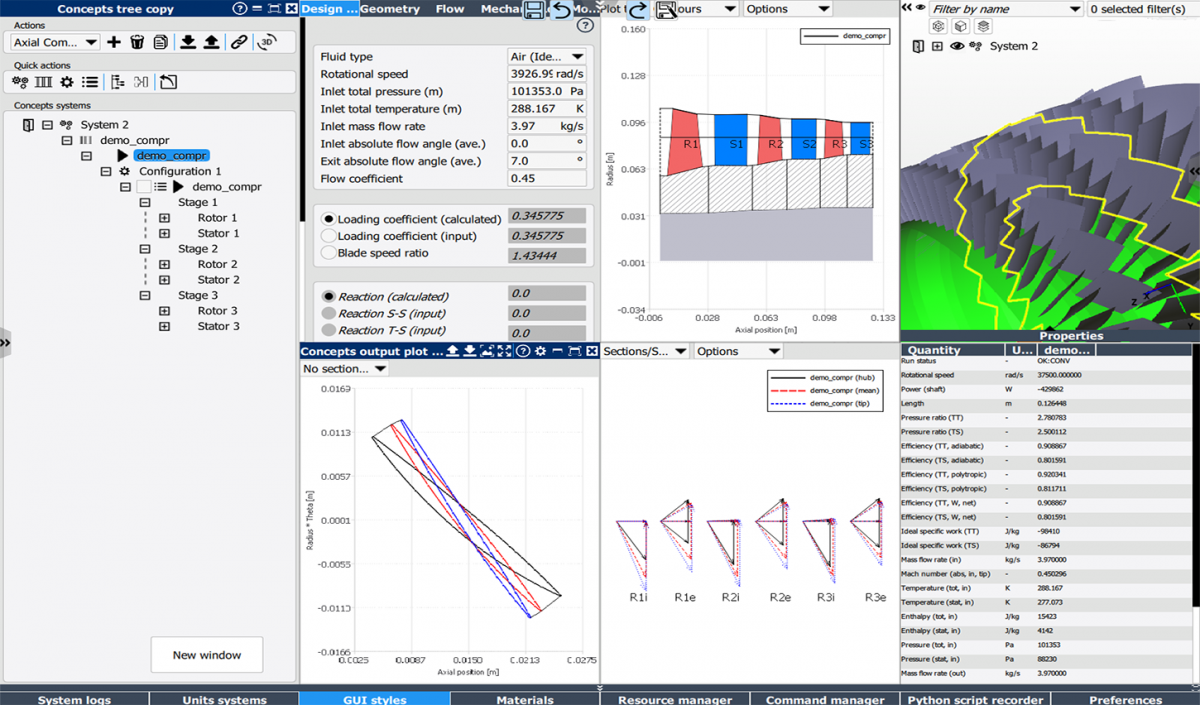

Extend the power of the Turbo CFD software with integrated preliminary and detailed design tools of the Agile package, thanks to our parnership with Concepts NREC.
Concepts NREC’s Computer-Aided Engineering (CAE) modules each have a unique Design Wizard that leads the user through all the necessary steps for design, analysis, and data reduction.
The meanline design can then easily be sent to AxCent® for detailed 3D design.
Structured & Unstructured seamlessly combined
The structured Turbo solver for rotating parts Omnis™/Turbo with Omnis™/AutoGrid structured meshes, offers unsurpassed speed and accuracy.
Combined with the unstructured Omnis™/Open-DBS solver, with Omnis™/Hexpress meshes, for peripherals such as volutes, inlets, etc.. the complete application is solved using the most optimal approach for each part.
Components range from multi-stage axial to radial to mixed-flow configurations: compressors, turbines, pumps, fans, propellers, contra-rotating propellers…
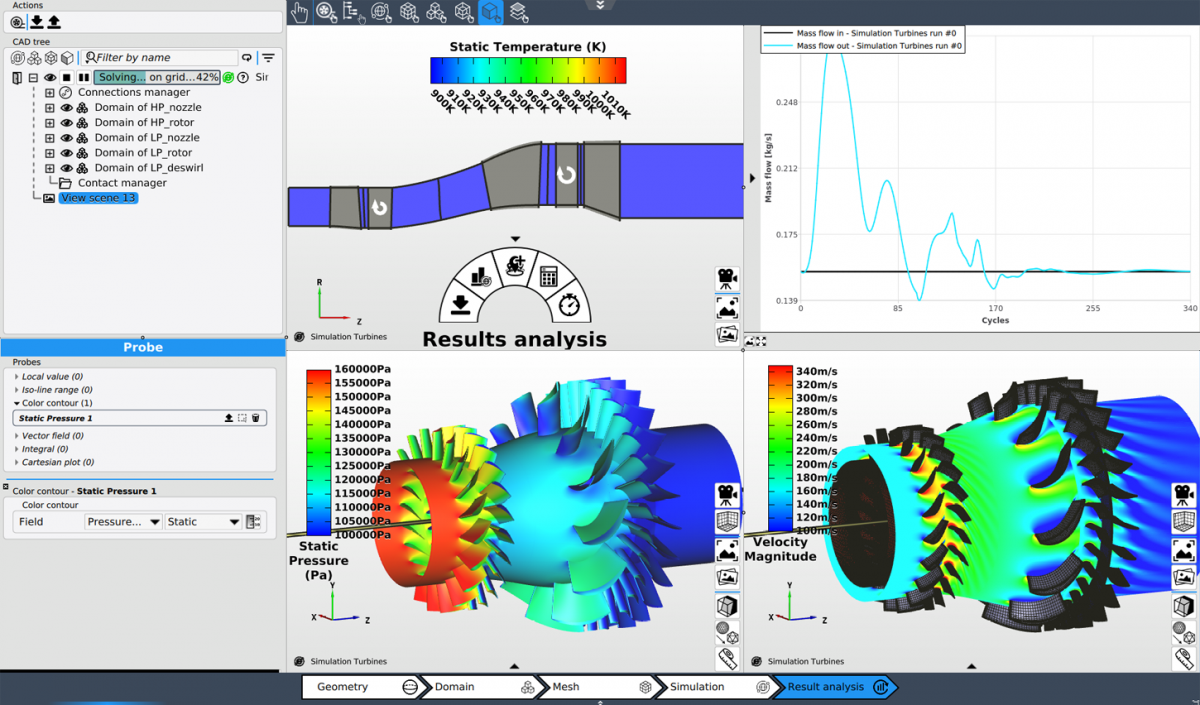
Non-Linear Harmonic method
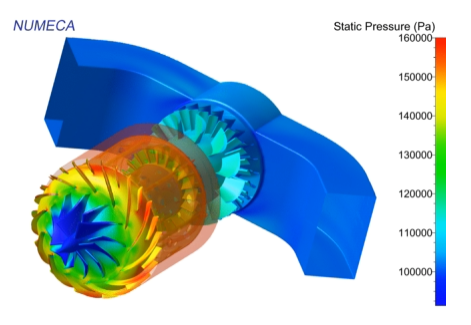
KJ66 static pressure
Gaining 3 orders of magnitude in solving speed for unsteady simulation.
With the Non-Linear Harmonic method, users can solve transient behavior 100 times faster, capturing clocking, blade row interactions, tonal noise, inlet distortion etc…
This unique technique computes the unsteady flow field by means of the Fourier decomposition of the periodic fluctuations, based on a pre-selected number of harmonics, typically associated with the blade passing frequencies and their multiples.
Users choose the frequencies and as many rotor-stator interactions as needed for their analysis.
Turnaround time 20x faster than any other solution on the market
The Omnis/Turbo CFD solution is optimized by scaling linearly on thousands of CPU cores, as well as on GPU (the latter provides a 2,4 times speed-up vs CPU).
Combined with our patented CPUBooster™ technology, a unique convergence acceleration technique, computation time is reduced even further, by a factor 3-5.
This package renders the solution up to 20 times faster than any other solution on the market.
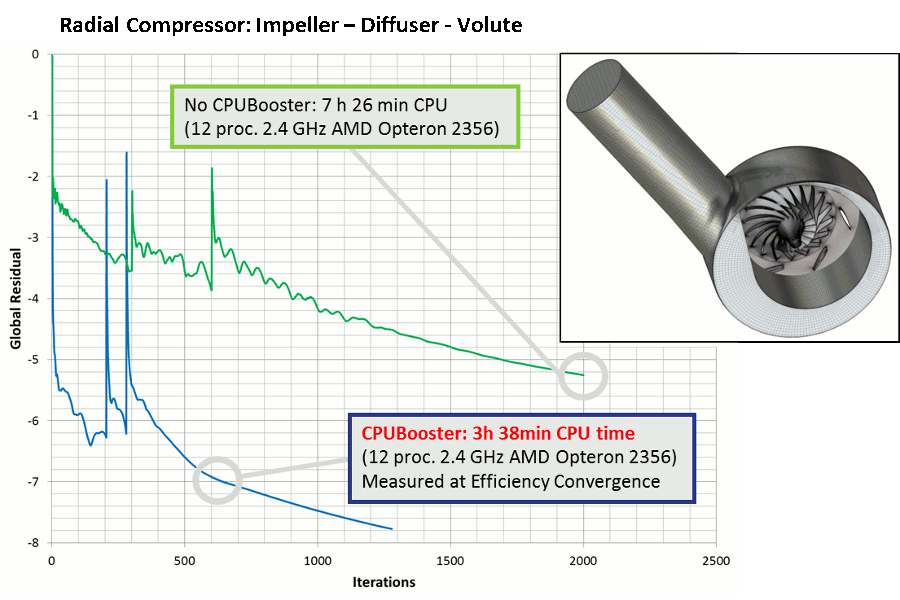
Simplifying complex physics
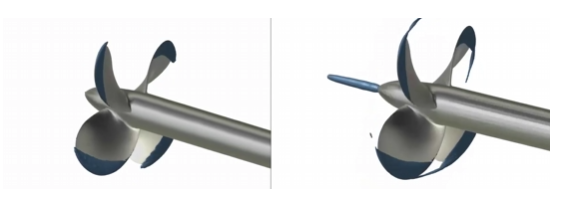
Cavitation inception: Left, no local refinement – Right, dynamic mesh adaptation
Solutions for some of the more challenging topics that CFD engineers still face today, such as:
• Conjugate Heat Transfer (CHT)
• Combustion (premixed and non-premixed)
• Cavitation
• and many more…
Full-engine 3D CFD simulation
With the purpose to meet the future requirements of aircraft engines in terms of low emissions, high reliability and efficiency, a novel highly efficient fully-coupled RANS-based approach has been developed, enabling the simulation of a full aero-engine within a single code.
One of the advantages of a fully coupled approach over a component-by-component approach, is that the boundary conditions at the interfaces do not need to be guessed.
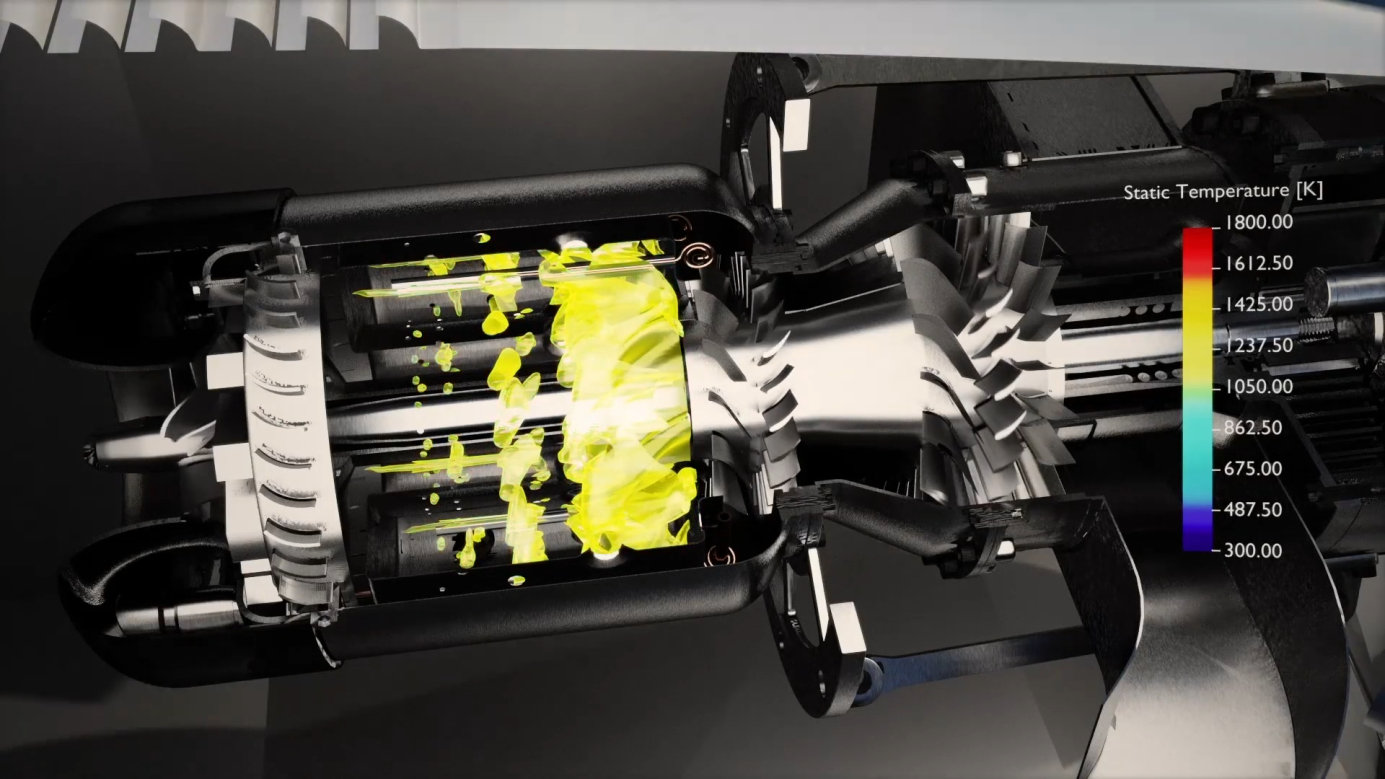
Computation of a full engine using Omnis™/Open-DBS’s NLH and combustion models
A Smart Interface methodology ensures a direct coupling between the different engine components, compressor- combustor-turbine, and allows the CFD models to vary between each component within the same CFD code.
For the simulation of the combustion process, the Flamelet Generated Manifold (FGM) method is applied. While the approach is superior to classical tabulated chemistry approaches and reliably captures finite-rate effects, it is also computationally inexpensive.
The Nonlinear Harmonic method is used to model the unsteady interaction between the blade rows as well as the influence of the non-homogeneities at the combustor outlet on the downstream turbine blade rows. This method is 2 to 3 orders of magnitude faster than a classical URANS simulation.
Fluid-Structure Interaction
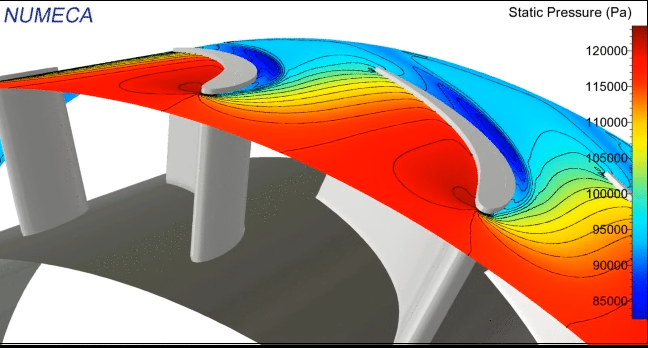
Set-up and start complete FSI simulations using only one software. FSI-OOFELIE couples the Finite Element solver Oofelie of Open Engineering with Cadence’s fast and accurate parallel flow solver Omnis™/Open-DBS with OpenLabs™ into one single environment.
The direct coupling within one single environment, allows for great gains in set-up time and reliability.
Aero-Vibro-Acoustics analysis
FINE™/Acoustics is a complete simulation suite for the analysis of a broad range of industrial applications involving Acoustics, Vibro-Acoustics and Aero-Acoustics.
Simultaneous tonal noise source and propagation analysis with the Non-Linear Harmonic method (NLH).
Broadband flow-noise source reconstruction based on steady RANS. Noise propagation with Boudnary Element Method (BEM) and Finite Element Method (FEM).

Optimization and Uncertainty Quantification
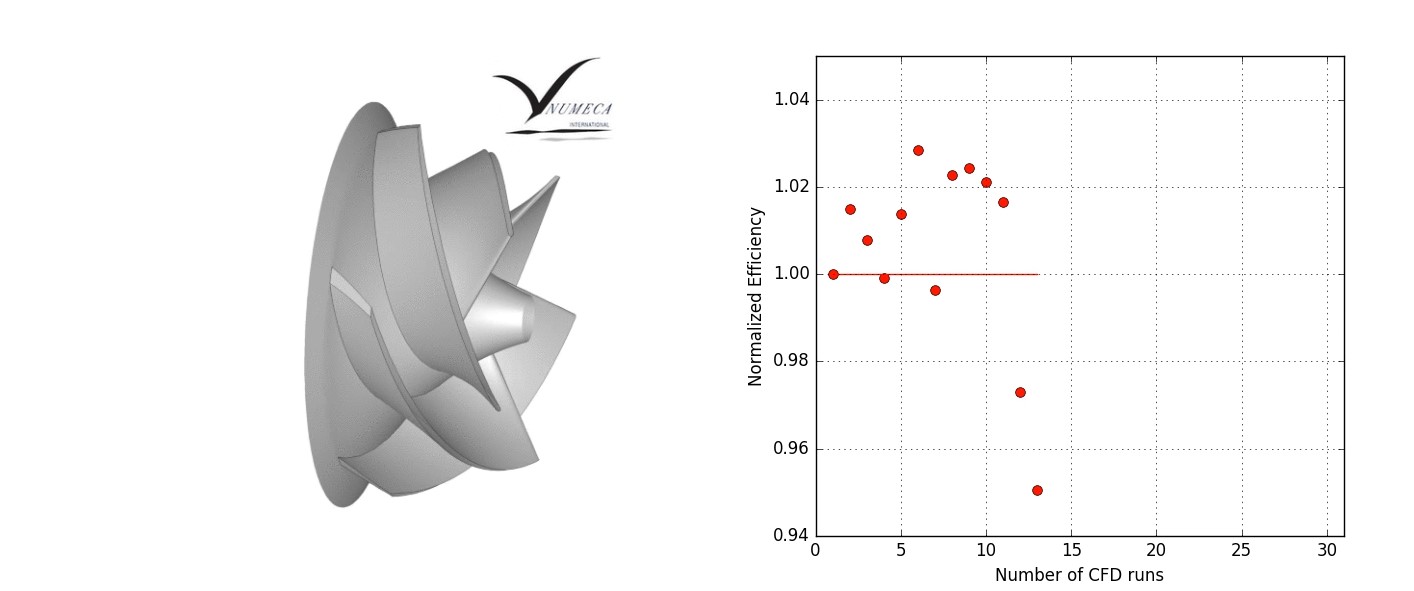
Automatic pump optimization with a limited number of design iterations
Maximizing performance and minimizing performance variability
The optimization framework FINE™/Design3D provides access to the Minamo optimization engine, boasting a number of cutting edge features in terms of Design of Experiments (DoE), model reduction, optimization algorithms and post processing.
Take into account uncertainties and quantify the influence of variability on the simulation prediction to ensure your optimization is in real life conditions.
Key Features
Meanline design
For all major turbomachinery configurations. Meanline options include:
• COMPAL® for radial and mixed-flow compressors
• PUMPAL® for radial, mixed-flow, axial pumps
• RITAL™ for radial and mixed-flow turbines
• AXIAL™ for axial compressors and turbines
Detailed 3D design
For geometry and blading using AxCent®, including throughflow, 2D blade to blade and streamline curvature calculation.
• 2D and radial blading
• Agile links to COMPAL®, PUMPAL®, RITAL™,AXIAL™, OMNIS™/Turbo, pbFEA and MAX-PAC
• Bezier-based cross-section (axial) and geometry generation (radial)
• Blade generation sheets
• Blade lean
• CAD output (IGES, STEP, ACIS, Parasolid, STL)
• Circular-arc and line segment contours
• Fillets (single-radious, variable, elliptical)
• Ideal and real fluids
• Independent hub and shroud
• Multistreamtube (MST) calculation for both compressible and incompressible flow
• Radial stacking of up to 3-cross-sections at LE, TE or CG
• Rapid loading calculation for both compressible and incompressible flow
• Single-blade raw capability
• Suitable for compressors, fans, pumps and turbines
• Swept leading and trailing edges
• Throat area calculation
• Add: BANIG
• Add: Blade stacking of 2 to unlimited number of cross sections
• Enhanced flank milling – confirming ruled surface
• Flow cuts and trims/extensions
• Flow injection and extraction
• Inlet boundary layer calculations
• Non-axisymmetric walls
• Parameterized blade types (MCA, DCA, Pritchard, Enhanced Pritchard)
• Parameterized blade types (NACA, Constant Passage, simple airfoil)
• Simple and independently-specified splitter blades (Independent was option)
• Stacking curve adjustment in meridional and tangential directions
Omnis™/AutoGrid
Parallel Mesh Generation
• Wizard mode: optimal mesh topology based on configuration
• Advanced geometry features: blade fillets, cooling systems, axisymmetric and non-axisymmetric effects
• Advanced configurations: multistage, bulb, unshrouded and by-pass
• Automated blocking and meshing of axisymmetric effects
• Python scripting technology
Omnis™/HEXPRESS
• Full Hexahedral Grids (no prism, no tetrahedra, no pyramid)
• Direct CAD import capabilities
• CAD manipulation and decomposition tools
• Mesh wizard for rapid solution set-up and easy back and forth operation
• Buffer cell and boundary layer insertion for high quality cells in boundary layer regions
• Automatic refinement procedures based on user defined sensors either next to solid walls or at specified area in the domain
• Multi domain capabilities allowing the treatment of CHT and multi-part geometry models
• Full non-matching multi-block connection, allowing multi-row turbomachinery meshing
Omnis™/Turbo flow solver
• One single code for all types of fluids (incompressible, perfect or real gas, compressible liquid and condensable) and speed (low speed to hypersonic regime)
• Acceleration with the CPU Booster™ module provides 3-5 times gain in convergence speed
• Non Linear Harmonic (NLH) module for full unsteady rotor-stator interactions with gains of 1 to 3 orders of magnitude in CPU time
• Cross-out High Performance Computing (HPC) on supercomputers with linear speed-up on up to 5,000 to 10,000 cores
• Embedded Fluid Structure Interaction (FSI) with the Modal and Flutter Analysis module
• Uncertainty Quantification module to study the variability with respect to geometrical or operational uncertainties
• Automated performance curve creation
• Multigrid convergence acceleration
• Full Non-Matching Boundaries capability
• Laminar-turbulent transition
• Congugate heat transfers
• Cavitation
• Python scripting technology
Omnis™/Open-DBS flow solver
• One single code for all types of fluids (incompressible, low-compressible, condensable and fully compressible) and speed (low speed to hypersonic regime)
• Acceleration with the CPU-Booster™ module provides 3-5 times gain in convergence speed
• Embedded fluid structure interaction with the Modal and Flutter Analysis module
• Multigrid convergence acceleration
• Multidomain capability
• Combustion
• Radiation
• Lagrangian multiphase
• Cavitation
• Multispecies reacting flows
• Thermodynamics tables and combustion tables generation
• Python scripting technology
OpenLabs™
• OpenLabs™ allows users to customize or add physical models
• Flexible and user-friendly Graphical User Interface
• Users don’t need to care about programming details and code structure
• OpenLabs can be used in a wide variety of industrial and academic applications
• Identical computing and memory costs compared to source-coded models
• Free access to all OMNIS™/Open community
Omnis™/Post
• Multi-projects and multi-views graphical user interface
• Python scripting technology
• Surface and 3D local value
• Iso-lines
• Color contour
• Vector
• Iso-surfaces
• Cloud of particles
• Line chart
• Integral
• Formula and operator derived quantities
• Live co-processing
Pars Makina From All Perspectives
Eco-Friendly
In all our projects that we carry out, we strive to use renewable energy sources and equally, we prefer to use recyclable materials.
Work Ethics
We add our motivation and ethical values to our continuous development efforts and we realize our projects through an evolving design that take into account feedbacks from numerous simulation and tests.
Safety
We always place safety the first place. We prioritize worker healthin all type of field works, factory production, assembly and tests carried out in our workshop.
Social Responsibility
Through the development of high and ınnovatıve technologies, we fulfil our duty regarding the development of our country and entire world wellness.
Advanced Technology
We always provide world-class engineering and production services with our R & D and production team that follows the technological state-of-the-art in our fields of expertise.
Customer Focused
We ensure customer satisfaction by providing efficient and reliable products that emanate from our responsible and positive-thinking attitude.
Look at Us More Closely
Pars Makina develops novel technological products that results from long term fundamental R&D studies. Our intellectual property contains many recent national and international patents that increase our worldwide competitiveness. For sustained growth of our capabilities and increased market share, we continue to produce state-of-the-art solutions involving high technologies. We also strive to work closely with national and international academic institutions and leading large companies in Turkey and Europe.
Pars Makina
We provide reliable, economical, high-power and efficient innovative solutions in the fields of Transport, Defence, Aerospace, Aerospace Engineering and Clean Energy.

